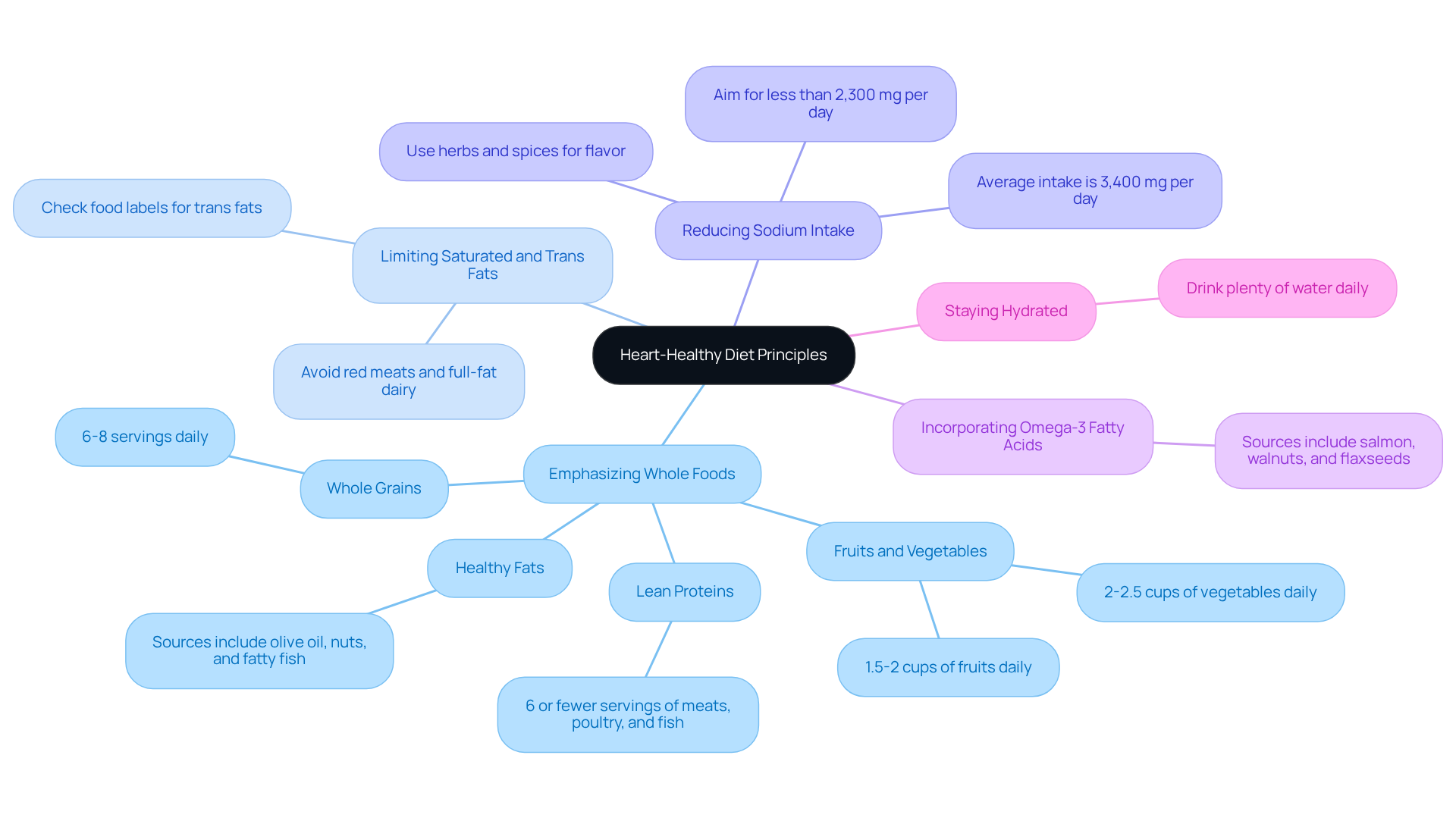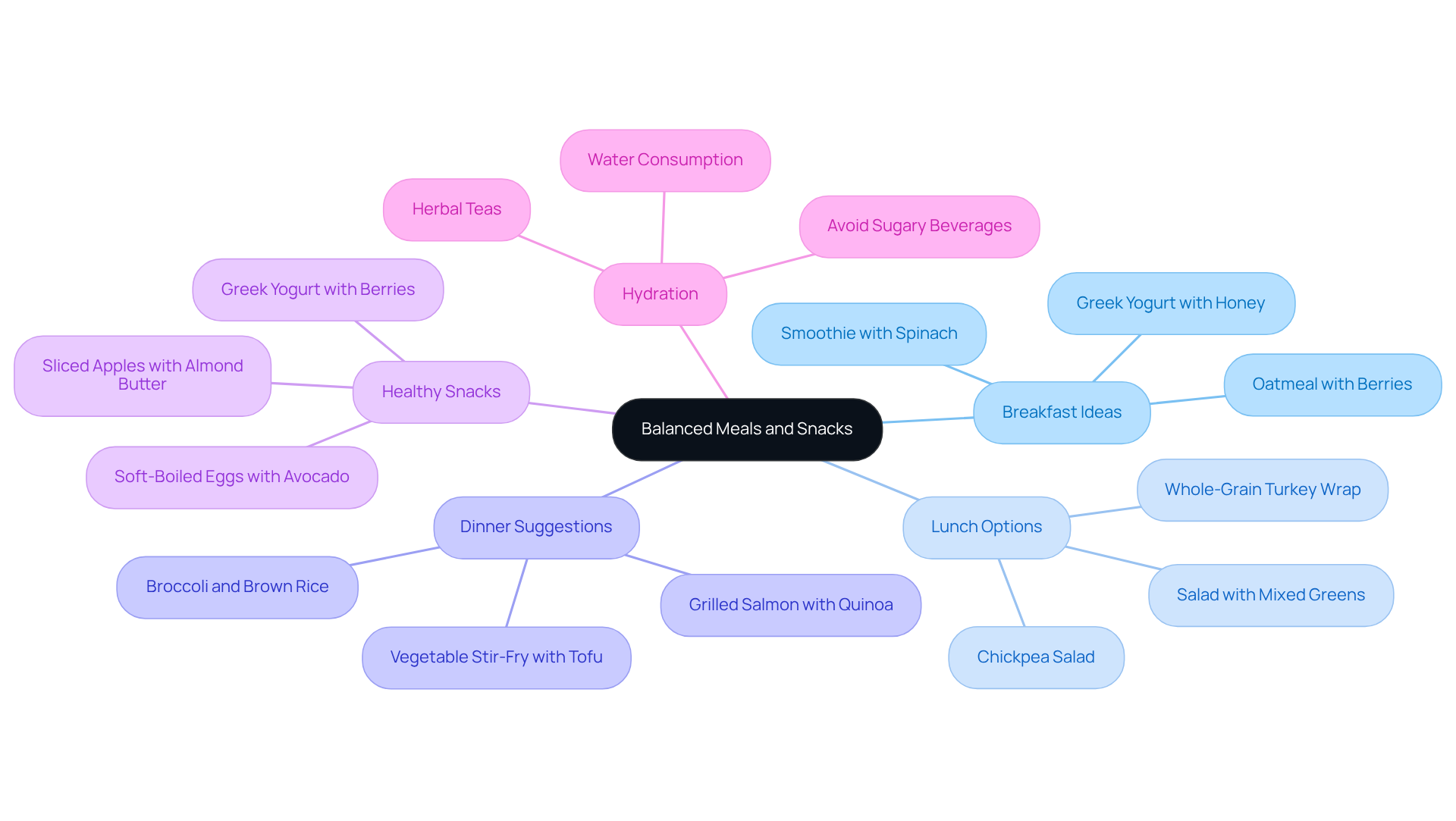


Creating a heart-healthy diet menu for seniors is an important step towards enhancing their well-being. It involves understanding key principles, such as:
Have you considered how these dietary choices can significantly impact cardiovascular health?
Meal planning is essential in this journey. By taking the time to monitor dietary habits, seniors can make informed choices that promote their heart health. Furthermore, these steps collectively support a healthier lifestyle, fostering a sense of empowerment and control over their well-being.
It's natural to feel overwhelmed by dietary changes, but remember, small steps can lead to significant improvements. With compassion and understanding, we can navigate these choices together, ensuring that every meal is both nourishing and enjoyable. Let’s embrace this opportunity to prioritize health and happiness.
Creating a heart attack diet menu is not just about choosing the right foods; it’s about embracing a lifestyle that prioritizes cardiovascular health, especially for seniors. We understand that navigating the complexities of heart-healthy eating can feel overwhelming, but this guide is here to help. It outlines essential steps that ensure older adults can enjoy flavorful meals while significantly reducing their risk of heart disease.
However, with so much conflicting information about dietary choices, you may wonder how to determine the best approach for maintaining heart health. Rest assured, you are not alone in this journey, and together we can find a path that feels right for you.
A heart attack diet menu that is beneficial for the cardiovascular system is essential for lowering the risk of cardiac conditions and improving overall vascular wellness. Let’s explore some key principles that can help you take charge of your heart health:
Emphasizing Whole Foods: It’s important to focus on incorporating a variety of fruits, vegetables, whole grains, lean proteins, and healthy fats into your meals. These nutrient-rich foods are low in unhealthy fats and added sugars, making them ideal choices for a heart attack diet menu. Did you know that studies suggest diets rich in whole ingredients can significantly reduce the risk of cardiovascular diseases, especially in older populations? The DASH diet, recognized as the 'Best Heart-Healthy Diet' and 'Best Diet for High Blood Pressure' in the 2025 Best Diets report by U.S. News & World Report, showcases a heart attack diet menu that highlights these whole foods and their many advantages.
Limiting Saturated and Trans Fats: It’s crucial to minimize the consumption of red meats, full-fat dairy products, and processed foods containing trans fats, as these can elevate cholesterol levels and increase heart disease risk. Instead, consider prioritizing lean protein sources and nutritious fats as part of your heart attack diet menu to support your cardiovascular well-being.
Reducing Sodium Intake: Aiming for a sodium intake of less than 2,300 mg per day can help manage blood pressure effectively. Currently, the average sodium intake among Americans is around 3,400 mg per day, which exceeds recommended levels. By utilizing herbs and spices for flavor, you can enhance your meals without the need for added salt. Studies show that even modest reductions in sodium can lead to significant improvements in blood pressure, especially among older adults. Dr. Aldo Moran emphasizes that small dietary changes can result in considerable wellness advantages.
Incorporating Omega-3 Fatty Acids: Including sources of omega-3 fatty acids, such as fatty fish (like salmon and mackerel), walnuts, and flaxseeds, is beneficial. These foods are known to reduce triglycerides and enhance cardiovascular well-being, making them an essential component of a heart-healthy diet.
Staying Hydrated: Maintaining proper hydration is essential for overall well-being. Drinking plenty of water throughout the day aids in digestion and nutrient absorption, contributing to better cardiovascular function.
By understanding and applying these principles, you can make informed dietary choices that align with your wellness goals, including a heart attack diet menu. Remember, these changes can lead to enhanced cardiovascular fitness and a better quality of life. You’re not alone on this journey; support is always available.

When selecting foods, it's essential to prioritize nutrient density—those nourishing options that provide a wealth of nutrients relative to their calorie content. Here are some gentle strategies to consider:
By concentrating on nutrient-rich foods and applying portion management, older adults can prepare meals that greatly enhance their cardiovascular well-being, following a heart attack diet menu. As the Mayo Clinic states, "If you follow these eight tips, you'll likely find that heart-healthy eating is something you can do and enjoy.

Creating a heart attack diet menu involves thoughtful planning to ensure that meals are balanced and nutritious, which is especially important for our older loved ones. Here’s how to do it:
Breakfast Ideas: Start the day with oatmeal topped with fresh berries and a sprinkle of nuts for added crunch, or a smoothie made with spinach, banana, and low-fat yogurt. These options not only offer vital nutrients but also promote muscle well-being with their protein content. Consider how starting the day with a nourishing breakfast can set a positive tone for the rest of the day.
Lunch Options: Prepare a salad with mixed greens, cherry tomatoes, chickpeas, and a vinaigrette dressing, or a whole-grain wrap filled with turkey, avocado, and plenty of veggies. Including protein-rich components such as chickpeas and turkey aids in preserving muscle mass, which is vital for older adults. Reflect on the joy of enjoying a colorful, healthy lunch that fuels the body.
Dinner Suggestions: Consider grilled salmon with quinoa and steamed broccoli, or a vegetable stir-fry with tofu served over brown rice. The heart attack diet menu includes meals that are abundant in omega-3 fatty acids and other nutrients that promote cardiovascular well-being. Imagine the comfort of a warm, nutritious dinner that nourishes both body and soul.
Healthy Snacks: Keep snacks simple and nutritious, such as sliced apples with almond butter, Greek yogurt drizzled with honey, low-sodium cottage cheese with pineapple, or soft-boiled eggs with avocado. These options are easy to chew and digest, making them appropriate for older adults. Think about how satisfying it can be to have healthy snacks readily available throughout the day.
Hydration: Motivate older adults to consume water or herbal teas during the day, steering clear of sugary beverages and restricting caffeine consumption to preserve overall well-being. Staying hydrated is essential for digestion and nutrient absorption. How can we encourage our loved ones to enjoy refreshing drinks that support their health?
By planning balanced meals and snacks, spacing them throughout the day, and focusing on protein-rich options, older adults can ensure they are meeting their nutritional needs while enjoying a variety of flavors. Remember, every small step towards better nutrition is a step towards a healthier, happier life.

To maintain optimal heart health, seniors are encouraged to actively monitor their dietary habits by following a heart attack diet menu and make necessary adjustments. Here are some effective strategies to consider:
As James M. Walker, a fourth-year M.D./MBA student, observes, "Food journaling for older adults helps you see what you eat every day." By consistently monitoring and adjusting their heart attack diet menu, seniors can take proactive steps towards better heart health while making informed choices that support their overall well-being.

Creating a heart attack diet menu tailored for seniors is a vital step towards enhancing cardiovascular health and reducing the risk of heart disease. By focusing on nutritious whole foods, managing portion sizes, planning balanced meals, and actively monitoring dietary habits, seniors can significantly improve their overall well-being. This comprehensive approach not only addresses immediate dietary needs but also fosters long-term heart health.
Key strategies discussed include:
Incorporating nutrient-dense foods and practicing mindful eating can lead to better digestion and satisfaction with meals. Furthermore, planning meals and snacks that are both nutritious and enjoyable ensures that dietary changes are sustainable and beneficial.
Ultimately, the journey to a heart-healthy diet is an empowering one. By taking small, manageable steps towards better nutrition, seniors can enhance their quality of life and promote cardiovascular wellness. Embracing these dietary principles not only supports individual health goals but also contributes to a community of informed and health-conscious individuals. Taking charge of heart health today can pave the way for a healthier tomorrow.
What is the importance of a heart-healthy diet?
A heart-healthy diet is essential for lowering the risk of cardiac conditions and improving overall vascular wellness.
What types of foods should be emphasized in a heart attack diet menu?
It is important to incorporate a variety of fruits, vegetables, whole grains, lean proteins, and healthy fats into meals. These nutrient-rich foods are low in unhealthy fats and added sugars.
What diet is recognized as the best for heart health?
The DASH diet is recognized as the 'Best Heart-Healthy Diet' and 'Best Diet for High Blood Pressure' according to the 2025 Best Diets report by U.S. News & World Report.
Why should saturated and trans fats be limited in the diet?
Limiting saturated and trans fats is crucial because they can elevate cholesterol levels and increase the risk of heart disease. Instead, lean protein sources and nutritious fats should be prioritized.
What is the recommended sodium intake for managing blood pressure?
The recommended sodium intake is less than 2,300 mg per day. The average sodium intake among Americans is around 3,400 mg per day, which exceeds this recommendation.
How can sodium intake be reduced in meals?
Sodium intake can be reduced by using herbs and spices for flavor instead of added salt, which can lead to significant improvements in blood pressure.
What are omega-3 fatty acids and why are they important?
Omega-3 fatty acids are found in foods like fatty fish, walnuts, and flaxseeds. They are beneficial because they reduce triglycerides and enhance cardiovascular well-being.
Why is staying hydrated important for heart health?
Staying hydrated is essential for overall well-being as it aids in digestion and nutrient absorption, contributing to better cardiovascular function.
How can dietary changes affect cardiovascular fitness?
Understanding and applying heart-healthy dietary principles can lead to enhanced cardiovascular fitness and a better quality of life. Small dietary changes can result in considerable wellness advantages.